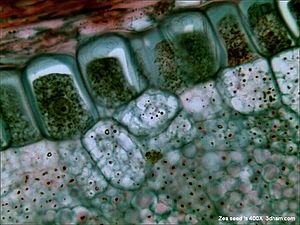Zea (plant) facts for kids
Quick facts for kids Zea (plant) |
|
|---|---|
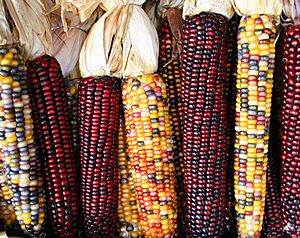 |
|
| Zea mays (corn) | |
| Scientific classification |
|
| Kingdom: | Plantae |
| Clade: | Tracheophytes |
| Clade: | Angiosperms |
| Clade: | Monocots |
| Clade: | Commelinids |
| Order: | Poales |
| Family: | Poaceae |
| Subfamily: | Panicoideae |
| Supertribe: | Andropogonodae |
| Tribe: | Andropogoneae |
| Subtribe: | Tripsacinae |
| Genus: | Zea L. |
| Type species | |
| Zea mays |
|
| Synonyms | |
|
|
Zea is a group of flowering plants that belong to the grass family. The most famous plant in this group is Z. mays, which you probably know as maize or corn. Corn is one of the most important crops for people all over the world.
Some wild types of Zea are called teosintes. These plants grow naturally in Mesoamerica, which is a region in Central America.
Contents
What Does the Name Zea Mean?
The name Zea comes from an old Greek word (ζειά). This word was used for another type of grain, possibly spelt.
Types of Zea Plants
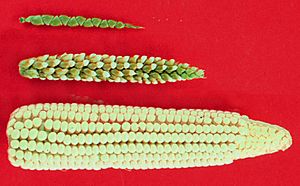
There are five main types, or species, of plants in the Zea group. Here are some of them:
| Ear | Plant | Scientific Name | Common Name | Where It Grows |
|---|---|---|---|---|
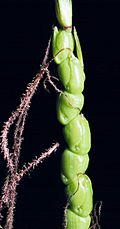 |
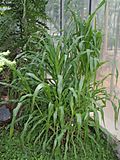 |
Zea diploperennis | Diploperennial teosinte | Jalisco, Mexico |
| Zea luxurians | Maíz de Monte, Florida teosinte, Guatemalan teosinte | Chiapas, Mexico; Guatemala; Honduras | ||
 |
 |
Zea mays | Corn, Maize | Southern Mexico, Guatemala; grown in many places |
| Zea nicaraguensis | Nicaraguan teosinte | Nicaragua | ||
| Zea perennis | Perennial teosinte | Jalisco, Mexico |
Zea mays (corn) is divided into four smaller groups called subspecies. Three of these are wild teosintes, and one is the corn we eat. The corn we eat is the only type of Zea that has been domesticated by humans.
How Zea Plants Look
Some teosinte species live for only one year (these are called annuals). Others live for many years (these are called perennials). For example, Z. diploperennis and Z. perennis are perennials. All other Zea species are annuals.
All Zea plants have 10 pairs of chromosomes, except for Z. perennis, which has 20 pairs. Scientists can tell the different types of teosinte apart by looking at their shape, their chromosomes, and their DNA.
Teosintes look a lot like corn, especially their male flower parts (called tassels). But teosintes have many branches. Each branch has small female flower parts that grow into tiny "ears." These ears have 5 to 10 black or brown seeds. Each seed is covered by a very hard shell. This shell protects the seeds from animals that eat them. It also helps the seeds spread when animals drop them in their waste.
How Corn and Teosintes Are Related
Teosintes are very important for understanding how corn developed. Most scientists believe that corn came directly from a teosinte called Z. m. parviglumis. Over time, people chose plants with traits they liked, which led to the corn we know today.
Wild teosintes often grow near corn fields. This means that corn and teosintes can sometimes mix their genetic material. This mixing is called introgression. Farmers sometimes find plants that are a mix of corn and teosinte in their fields.
In some parts of Mexico, farmers see teosintes as a weed because they compete with corn. But in other areas, farmers think teosintes are helpful. They even encourage them to grow with their corn.
Where Corn Spread in the Americas
Scientists have studied the genes of early corn plants. They found that corn spread in the Americas in different ways:
- One group of corn plants with unique "hand-grenade-shaped" ears grew in the Andes Mountains.
- Another group included corn from other parts of South America and Mexico.
- A third group was found in the United States.
It seems that corn from the Andes Mountains came from corn in the lowlands of South America. And that corn, in turn, came from the lowlands of Guatemala and southern Mexico.
Zea Plants and Their Environment
Zea plants are a food source for the larvae (caterpillars) of many types of moths and butterflies. These include pests like the fall armyworm and the corn earworm.
Most wild teosinte populations are in danger of disappearing. For example, Z. diploperennis grows in a very small area. Z. nicaraguensis has only about 6,000 plants left in a tiny space. The governments of Mexico and Nicaragua are working to protect these wild teosinte plants.
Scientists are very interested in using good traits from teosintes to improve cultivated corn. For example, some teosintes can fix nitrogen in the soil, resist insects, live for many years, or handle floods. It is hard to transfer these good traits to corn without also bringing along traits that are not helpful.
Images for kids
See also
 In Spanish: Zea para niños
In Spanish: Zea para niños


